Climate Change Countermeasures
The Chugai Group will create and promote new environmental measures in collaboration with business partners and academia to reduce greenhouse gas emissions and achieve more efficient energy use, with challenging goals based on international agreements and so forth.
Mid-Term Environmental Goals 2030 and FY2024 Results
| Material issues | KPIs | Goals (Base year 2019) | 2024 results |
|---|---|---|---|
| Climate change countermeasures (prevention of global warming) | Scope 1+2*1 CO2 emissions |
40% reduction by 2025 60~75% reduction by 2030 Zero emissions by 2050 |
52.2% reduction |
| Scope 1+2*1 Energy reduction |
5% reduction by 2025*2 15% reduction by 2030*2 |
12.3% reduction | |
| Sustainable electricity ratio | 100% by 2025 | 97.3% | |
| Fuel consumption by MR vehicles | 35% reduction by 2025 75% reduction by 2030 |
45.7% reduction | |
| Halogenated hydrocarbons | 25% reduction by 2025 100% reduction by 2030 (Base year 2020) |
16.8% reduction | |
| Scope 3*1 CO2 emissions |
30% reduction by 2030 | 1.5% increase |
- *1 Scope 1: Direct emissions from fuel combustion, Scope 2: Indirect emissions from the generation of purchased energy, Scope 3: Indirect emissions other than Scope 1 and Scope 2 (Target added in 2021)
- *2 Per total floor area (Excluding leased properties)
Independent assurance of environmental performance data
Environmental performance data is subject to third-party assurance to ensure its reliability. The data indicated with a third-party assurance mark for the year of 2024 have been independently assured by KPMG AZSA Sustainability Co., Ltd.
for the year of 2024 have been independently assured by KPMG AZSA Sustainability Co., Ltd.
Independent Practitioner’s Limited Assurance Report [PDF 4.3MB]
Sustainability Data 2024
Reducing GHG*1 Emissions
*1 GHG: Greenhouse Gas
GHG emissions in 2024
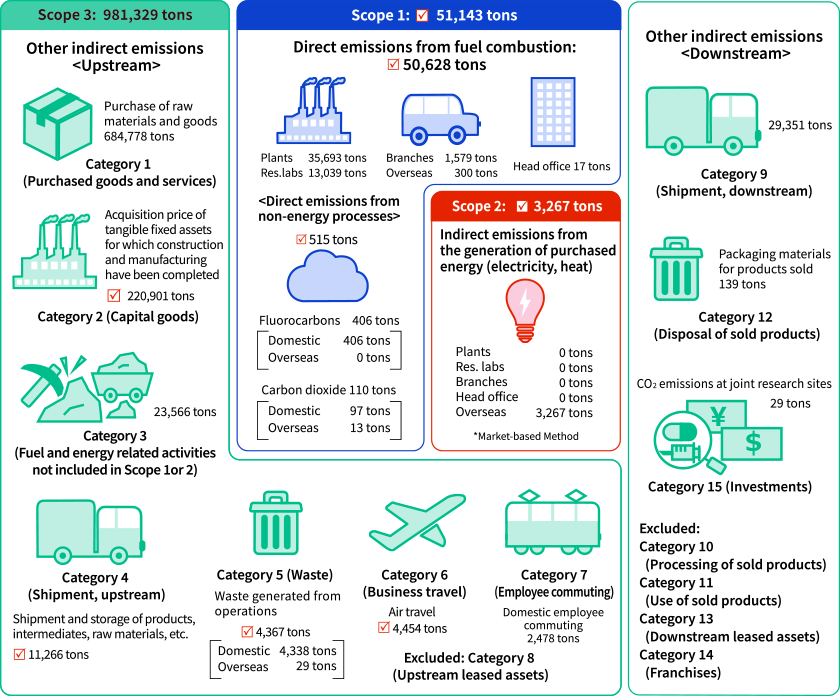
Scope 1, Scope 2 and Scope 3 emissions were 51,143 tons, 3,267 tons and 981,329 tons, respectively. Scope 1 emissions are CO2 emitted directly by the Group. These include CO2 emissions associated with the use of gasoline, diesel, fuel oil, city gas, and LPG, and emissions of chlorofluorocarbons and carbon dioxide gas, etc. Scope 2 emissions are indirect CO2 emissions associated with the use of energy supplied by others (such as electricity). We have promoted the conversion to sustainable electricity, resulting in zero Scope 2 emissions domestically from 2023. Scope 3 emissions are all other indirect CO2 emissions from activities of the organization other than Scope 1 and 2. In 2024, Category 1 (Purchased goods and services) accounted for 70% of Scope 3.
Note that the emission factors used in calculating energy and CO2 emissions and the calculated boundary of each scope and category are listed in Sustainability Data 2024.
2024 CO2 emissions from energy consumption, by function (Scope 1 and 2)
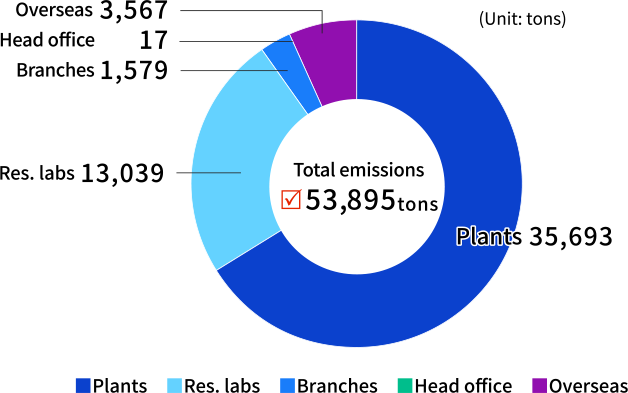
Manufacturing plants are the function with the highest emissions at 35,693 tons, followed by research laboratories at 13,039 tons, branch offices at 1,579 tons and the head office at 17 tons. Total emissions from research, production and sales sites overseas totaled 3,567 tons.
2024 CO2 emissions from energy consumption by energy type (Scope 1 and 2)
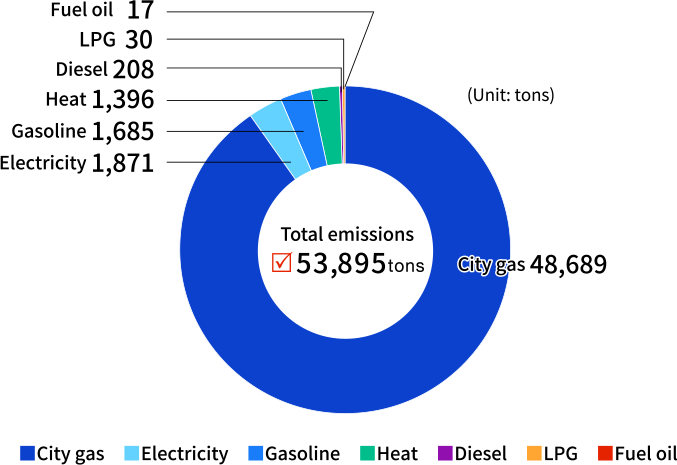
The energy type with the largest volume of emissions is city gas at 48,689 tons, followed by electricity at 1,871 tons, gasoline at 1,685 tons, heat at 1,396 tons, diesel at 208 tons, LPG at 30 tons and fuel oil at 17 tons.
Change in CO2 emissions from energy consumption by energy type (Scope 1 and 2)

Scope 1 and Scope 2 emissions from energy consumption decreased by 52.2% from the base year level to 53,895 tons. There was a slight increase of 6.1% compared to the previous year, due to test operations associated with the start-up of the new building. In terms of Scope 2 emissions, in 2021 factories and research laboratories that consume a lot of electricity started to switch to sustainable electricity provided by electric power companies, and by utilizing Non-Fossil Fuel Certificates at our head office and branches, we have achieved 100% sustainable electricity use across the entire Group in Japan. Overseas business sites are also promoting the use of sustainable electricity, and in 2025 the Chugai Group as a whole is expected to achieve a sustainable electricity ratio of 100% as stated in its Mid-term Environmental Target 2030. In order to achieve our Mid-term Environmental Target 2030, we also need to reduce direct CO2 emissions from fuel use (Scope 1), so we are considering conversion of existing facilities as well as facility consolidation and redesign.
To address the global social issue of climate change, we will look further ahead and actively contribute to solving social issues by setting and implementing a long-term goal of zero CO2 emissions by 2050.
For more information on the Mid-term Environmental Target 2030, please click here.
Change in Scope 3 Emissions
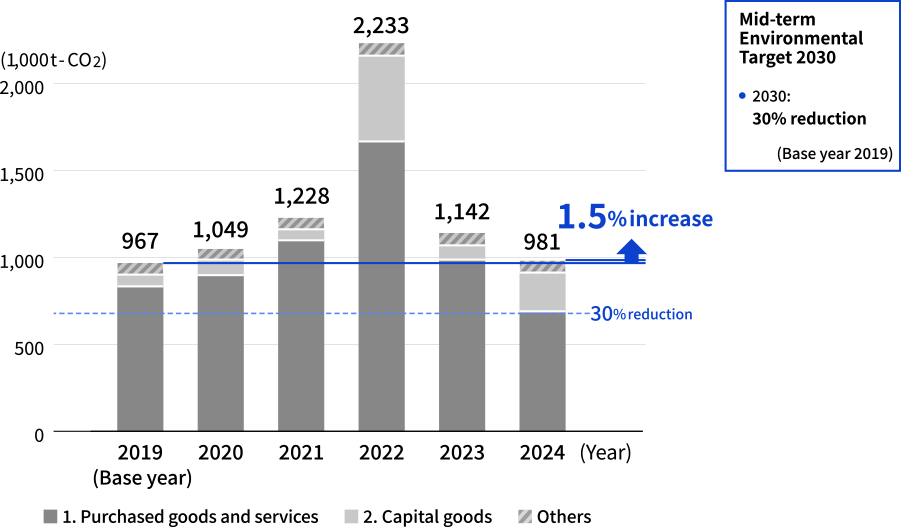
* There was an error in the calculation of Category 5 (waste) under “Others,” and the figures for “Others” from 2019 to 2023 have been corrected accordingly.
Scope 3 emissions were 981,329 tons, 1.5% increase from the base year. In Category 1 (Purchased goods and services), there was a 30.8% reduction compared to the previous year, due to a decrease in the amount of goods and services purchased and a reduction in CO2 emissions by suppliers. In addition, in Category 2 (Capital goods), there was a significant increase in 2022 with the completion of the Chugai Life Science Park Yokohama, but this subsided in 2023. In 2024, emissions increased by 178% from the previous year, both changes driven by the construction of new buildings at the Ukima and Fujieda sites. We believe that it is important to take action to reduce CO2 emissions throughout the supply chain in order to realize a sustainable society. To this end, we have set a CO2 emissions reduction target of 30% by 2030, and we will encourage suppliers who have not set CO2 emission reduction targets to set and promote them.
Reducing Energy Consumption
Change in energy consumption
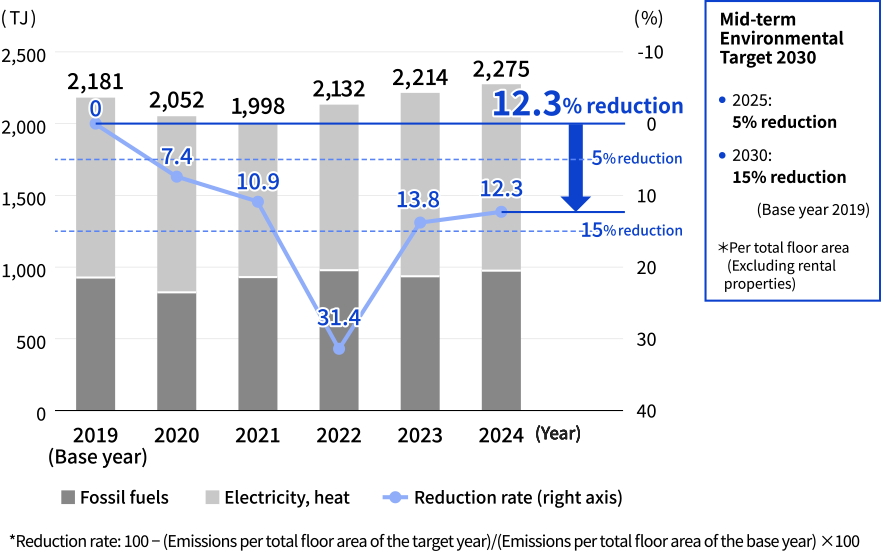
Energy consumption in 2024 was 2,275 TJ, and energy consumption per total floor area was 6.3 GJ/m2, a 12.3% decrease from the base year and a 1.7% increase from the previous year. In 2022, the newly completed Chugai Life Science Park Yokohama and the Kamakura and Fuji Gotemba Laboratories, were operating simultaneously, resulting in an increase in total floor area, which in turn reduced energy consumption per total floor area. On the other hand, due to the closure of the Kamakura and Fuji Gotemba Research Laboratories in 2023, energy consumption per total floor area increased. As a result, energy consumption has fluctuated up and down since 2021.
In order to achieve “the reduction of energy consumption per total floor area by 5% in 2025 and 15% in 2030 compared to 2019 (mid-term environmental target 2030)”, we are promoting efforts to reduce energy consumption through several actions such as introducing high energy efficiency equipment, fuel conversion, introduction of eco-cars, and energy-saving campaigns in our business activities.
Discontinuation of / Conversion from Fluorocarbons
Change in fluorocarbon holdings and supplementation due to leakage in 2024

In 2024, fluorocarbon holdings were 37,027 kg, a decrease of 6,818 kg from 2023. In order to achieve a 100% reduction in usage of fluorocarbons by 2030, we are promoting initiatives with specific action plans, such as verification of alternative technologies, and installation of natural refrigerants when constructing new buildings or renewing equipment. In 2024, the Ukima Business Site commenced operation of UK4, a biopharmaceutical manufacturing building that is completely free of chlorofluorocarbons (CFCs).
At Chugai Life Science Park Yokohama, the Welfare Building (Nijikake Nursery School) was the first in the Chugai Group to install a room air conditioning system that uses CO2 refrigerant, a natural refrigerant, after repeated discussions with an air conditioning equipment company. In addition, in the research building, we have, with the cooperation of manufacturers, introduced centrifuges and ice machines that use natural refrigerants. Going forward, we will continue to upgrade to equipment that uses new refrigerants (green refrigerants), actively promote technological developments with construction companies and equipment/device manufacturers, promote conversion to new refrigerants (green refrigerants) with low greenhouse effect, and work on climate change countermeasures.
Moreover, as a measure against leakage due to aging equipment and other factors, we have been working to upgrade our equipment starting in 2022. As a result, the amount of fluorocarbons used to refill equipment in 2024 (amount of fluorocarbons leakage) could be reduced to 406 t-CO2e. We will continue to optimize our voluntary management by gaining an understanding of the amount of fluorocarbons leaked.
Please see the following page for details on the use of CO2 refrigerant in room air conditioning.
New Research Center “Chugai Life Science Park Yokohama” adopting Natural Refrigerant Air Conditioning System in the Welfare Bldg. (Medium-Term Environmental Target: Reduce fluorocarbons usage by 100% by 2030)
Status of Introduction of Eco-friendly cars
Change in total fuel consumption of commercial vehicles
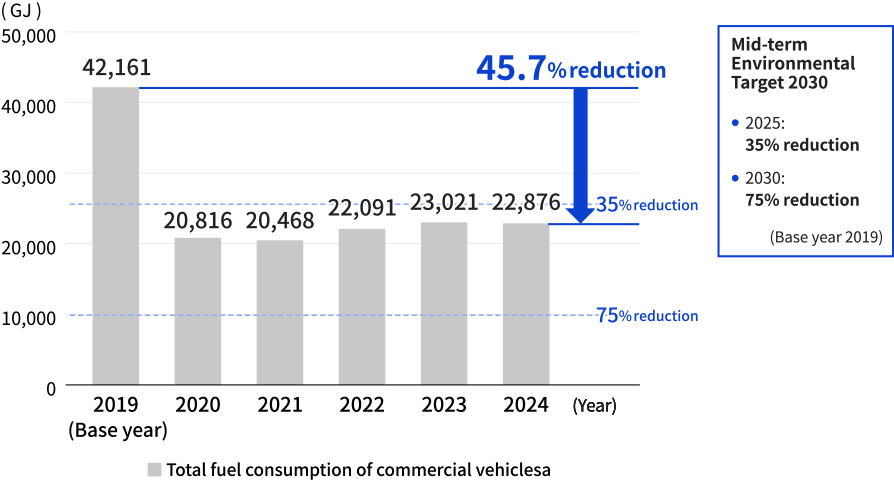
At the end of 2024, the introduction rate of eco-friendly cars for commercial vehicles was 93%, and the total fuel consumption was 22,876 GJ, a decrease of 45.7% compared to the base year. Although there was a 4% decrease compared to the previous year, due to the gradual recovery of sales activities, which had been restricted due to the COVID-19 pandemic, it has increased by 4% from 2022. The Group will further strengthen its efforts to introduce eco-friendly vehicles such as hybrid cars and highly fuel-efficient vehicles, and will consider the introduction of electric vehicles and other measures to reduce the total fuel consumption of commercial vehicles by 75% by 2030.
Certification and Disclosure of Information on Climate Change Measures
- TCFD*1 Disclosure Based on Proposals: Analysis as of 2023
- SBT*2 Certified in November 2021
- CDP*3 Climate Change A-List Selection
- *1 TCFD: Disclosure of climate-related information that has a financial impact on the company
- *2 SBT (Science Based Targets): Greenhouse gas emission reduction targets set by companies for the next five to 15 years, consistent with the levels required by the Paris Agreement
- *3 CDP: An international non-governmental organization (NGO) established in the United Kingdom to promote the disclosure of environmental information
Click here for more information

